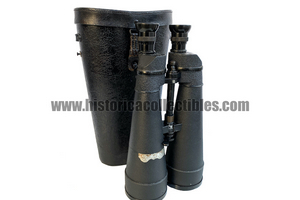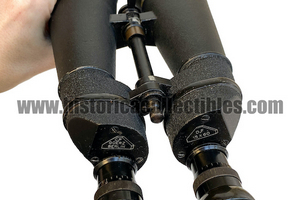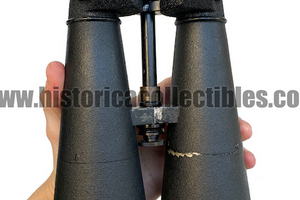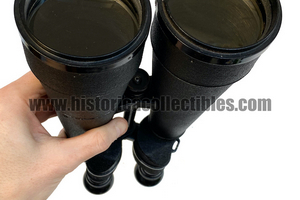Doppelfernrohr C.P. Goerz 15x60 Mod. Pernox, about 1925
Doppelfernrohr 15x60 model Pernox, produced by C.P. Goerz around 1925.
The binoculars are almost completely made of aluminum; on the left eyepiece plate there is the manufacturer's mark "C.P.Goerz Berlin", on the right one its technical data: "D.F. 15x60".
At the base of both eyepieces there is a threaded washer mechanism that locks the eyepiece base itself once the perfect collimation has been found, which can then be found simply by rotating the eyepiece bases as they rotate eccentrically.
The binoculars are built in very few examples and the exact production quantity is not known to this day. This binoculars are however the most advanced model of the "Pernox" line as the previous models had very different shapes and technical characteristics.
The considerable magnifications with which it is equipped are suitable for the observation of targets placed at long distances and place its use in some military units of the newly formed Weimar Republic. In fact, this binoculars appear published in a C.P. Goerz catalogue from around the 1920s, where its possible intended use and all the technical characteristics are specified.
The binoculars are in excellent condition, the view is perfectly clear, sharp and collimated, the mechanisms work correctly and it is also complete with its original leather case.
We are currently aware of only two other specimens in private collections.
The C.P. Goerz was a company of optical and photographic instruments founded in Berlin in 1886 by Carl Paul Goerz (1854-1923), together with Carl Moser, optical researcher, and Ottomar Anschutz, laboratory technician in close friendships; precisely from this last C.P. In 1889, Goerz had purchased the patent for the construction of the first shutter for cameras capable of shutter speeds of 1/1000 of a second.
The company specialized in the production of lenses, cameras, telescopes and binoculars, including for military use. In 1886 it had around 25 employees, which rose to 2500 in 1911, although at its maximum expansion the workforce reached 10,000 employees.
In terms of size it was not even second to Zeiss (which in the same period had 1000 fewer workers), and it exported to many countries, including Russia and the United States. In 1905 Goerz American Optical continued to operate independently in the United States until 1972. In 1908 Goerz Photochemisches Werk GmbH was founded in Berlin, this section of the Goerz group produced film for photography and cinema.
Goerz had a fundamental relationship with the armies of the time and military supplies. In fact, it remained famous both for the large trench binoculars (First World War) and for the binoculars supplied to all the weapons of the Austrian-German Army (including navy and air force) as well as Bulgaria, Romania etc. Even today there are countless examples of Goerz binoculars that have value on the war and optical antiques market, one must think that in 1906 Goerz had already produced and exceeded 100,000 "Triëder" model binoculars, both for civil and military use.
In addition to the main and historic factory in Friedenau (Berlin), C.P. Goerz was also present in London, Paris and Vienna, Bratislava, Milan, Riga and St. Petersburg. Other sections were dedicated to chemical products and also for typewriters or calculating machines, which a division of the company was responsible for producing until 1945.
In 1910 the company bought the "Sendlinger Optische Galswerke" company founded by J. Von Fraunhofer and C. A. Steinheil for the production of optical glass and mirrors, which made it completely independent from purchasing from other retailers. After the First World War, with the Treaty of Versailles, the German companies that had produced war material were slowed down in production and this quickly led to a serious economic situation.
In 1923 Paul Goerz died and the company, which was in bankruptcy, was purchased by Zeiss which, together with the companies "Contessa", "Nettel", "ICA" and "Ernemann" founded Zeiss Ikon in 1926. The American division of Goertz became an independent company under the name Goertz American Optical Co. producing camera lenses and continuing their technical development. In 1971 it was bought by Kollmorgen, which was absorbed by Schneider Optics in 1972.




